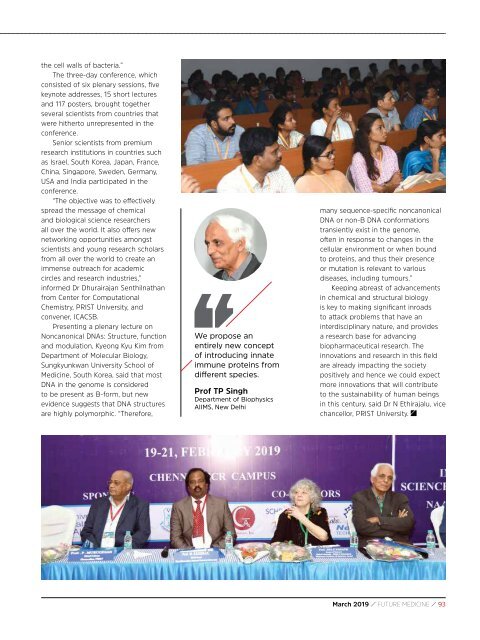March 2019 digital v1
Create successful ePaper yourself
Turn your PDF publications into a flip-book with our unique Google optimized e-Paper software.
the cell walls of bacteria.”<br />
The three-day conference, which<br />
consisted of six plenary sessions, five<br />
keynote addresses, 15 short lectures<br />
and 117 posters, brought together<br />
several scientists from countries that<br />
were hitherto unrepresented in the<br />
conference.<br />
Senior scientists from premium<br />
research institutions in countries such<br />
as Israel, South Korea, Japan, France,<br />
China, Singapore, Sweden, Germany,<br />
USA and India participated in the<br />
conference.<br />
“The objective was to effectively<br />
spread the message of chemical<br />
and biological science researchers<br />
all over the world. It also offers new<br />
networking opportunities amongst<br />
scientists and young research scholars<br />
from all over the world to create an<br />
immense outreach for academic<br />
circles and research industries,”<br />
informed Dr Dhurairajan Senthilnathan<br />
from Center for Computational<br />
Chemistry, PRIST University, and<br />
convener, ICACSB.<br />
Presenting a plenary lecture on<br />
Noncanonical DNAs: Structure, function<br />
and modulation, Kyeong Kyu Kim from<br />
Department of Molecular Biology,<br />
Sungkyunkwan University School of<br />
Medicine, South Korea, said that most<br />
DNA in the genome is considered<br />
to be present as B-form, but new<br />
evidence suggests that DNA structures<br />
are highly polymorphic. “Therefore,<br />
We propose an<br />
entirely new concept<br />
of introducing innate<br />
immune proteins from<br />
different species.<br />
Prof TP Singh<br />
Department of Biophysics<br />
AIIMS, New Delhi<br />
many sequence-specific noncanonical<br />
DNA or non-B DNA conformations<br />
transiently exist in the genome,<br />
often in response to changes in the<br />
cellular environment or when bound<br />
to proteins, and thus their presence<br />
or mutation is relevant to various<br />
diseases, including tumours.”<br />
Keeping abreast of advancements<br />
in chemical and structural biology<br />
is key to making significant inroads<br />
to attack problems that have an<br />
interdisciplinary nature, and provides<br />
a research base for advancing<br />
biopharmaceutical research. The<br />
innovations and research in this field<br />
are already impacting the society<br />
positively and hence we could expect<br />
more innovations that will contribute<br />
to the sustainability of human beings<br />
in this century, said Dr N Ethirajalu, vice<br />
chancellor, PRIST University.<br />
<strong>March</strong> <strong>2019</strong> / FUTURE MEDICINE / 93


















